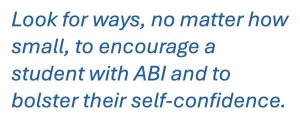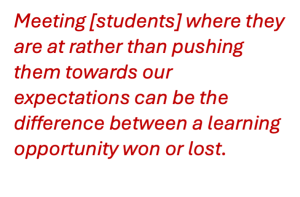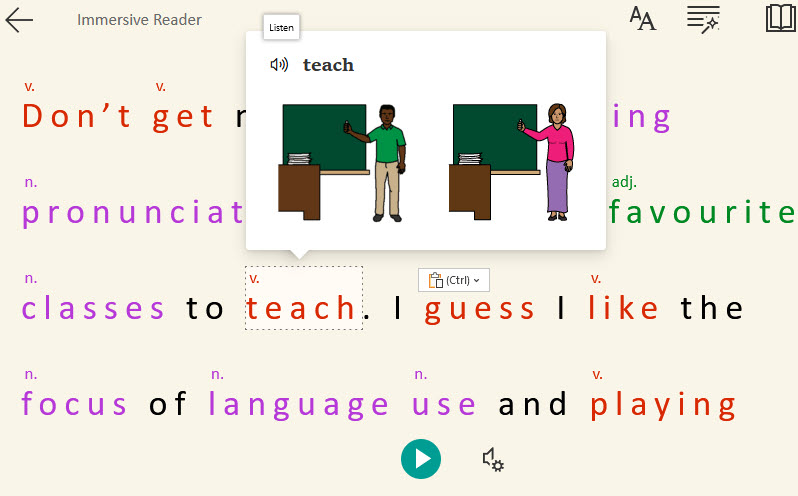Many lower level students are living with the effects of Acquired Brain Injury (ABI) from trauma, such as concussions, infection, and strokes. They struggle, while other students are learning and progressing. No matter how many times and ways we cover the same material, do the same activities, these struggling students still battle and labour to learn. It’s a situation of snakes and ladders. One day they seem to get it, have some sort of breakthrough, only to return to their old patterns of difficulty. Teacher and student have to begin all over again.
Category Archives: Literacy
When the Moment Calls for Differentiated Instruction
We sometimes forget that learners are at different points along the learning continuum. Our students range from beginning to advanced, and all points in between. While we pitch our lessons to the middle, and expect our students to meet the objectives, the students at the lower end of the continuum tend to get left behind. Yet, these learners present us with the greatest opportunity for teaching and learning in the use of differentiated instruction.
Continue readingFour Tips For Teaching A Literacy Class
Hands down, foundation literacy is the most challenging level to teach in language instruction. In fact, it’s a completely different universe from the other CLB levels, even CLB 1. If you’ve ever taught a literacy class, along with a CLB 1 class, as I did this year, you’ll see how dramatic the differences are between the students. A teacher sees that the approaches, strategies, and pedagogy they use for the other levels don’t apply to a literacy class. With that in mind, here are four hard-earned principles I learned from my past year teaching literacy.
Continue readingThe Importance of Selecting Appropriate Reading Materials – How to Help Learners Find the “Right” One
Learners often come to me with questions about their English reading materials. They wonder if the books they’ve chosen are good for practicing English or why certain expressions differ from what they hear daily. For instance, one of my students asked why “you shall” was used in a text. This highlighted a common issue: many learners struggle to distinguish between reading for pleasure and reading to learn English as a second language. This leads to a vital question: How does one choose a book that benefits English learning? However, selecting the right materials involves more than just finding any English text—it requires careful consideration of the learner’s proficiency level and the regional variation of English they are exposed to.
Continue readingSimplifying Real-World Content with ChatGPT and the Canadian Language Benchmarks
Lesson planning can be a time-consuming endeavor, especially for educators teaching students with lower levels of English proficiency. Adapting materials to meet the needs of these learners requires careful consideration and often entails significant effort. However, with the assistance of tools like ChatGPT, this process can be streamlined and made more efficient.
Continue readingSupporting Literacy Students to Become Independent Learners
I was taking the chairs down from the desks and putting them on the floor before the morning class, when a student came in and said:
“Teacher.”
She shook her head and pointed to herself.
“Me,” she said.
She motioned for me to sit. Since that day, the students have put themselves in charge of the chairs.
Immersive Reader for Autonomous Reading Practice
Introduction
In 2018, Beth Beardall posted that reading advances learner grammar comprehension, vocabulary, writing skills, critical thinking skills and speaking fluency in the post Reading, Reading, Reading. Why it is so important! One way to assist your learners with reading is to encourage them to use the Microsoft Immersive Reader tool.
Continue readingQuick Tips for Teaching Literacy – Part Three of Three

Guest Contributor: Zainab Almutawali
In Part One and Part Two of this series I’ve talked about issues that may affect attendance for literacy learners, as well as some best practices I’ve picked up over the years. In this post, I’ll pass along some more effective teaching practices for literacy learners and tips on PBLA.
Quick Tips for Teaching Literacy – Part Two of Three
Guest Contributor: Zainab Almutawali
In Part One, I talked about the background of literacy students and issues regarding their attendance. In this post, I’ll be listing some of the best teaching practices that I find useful from my personal experience teaching literacy students.
Continue readingQuick Tips for Teaching Literacy
Guest Contributor: Zainab Almutawali
These tips and guidelines are meant for instructors and volunteers who are new to the field of literacy and intend to work with adult literacy learners. What makes this document different is that it is not based on research papers and teaching theories. Rather, it is based on my experience teaching literacy students from diverse backgrounds and various levels of literacy. It is also based on other teachers’ experiences and my learners’ feedback, which I always consider when planning my lessons. Despite the challenges, I find that teaching literacy is very rewarding and fulfilling.
Continue reading







